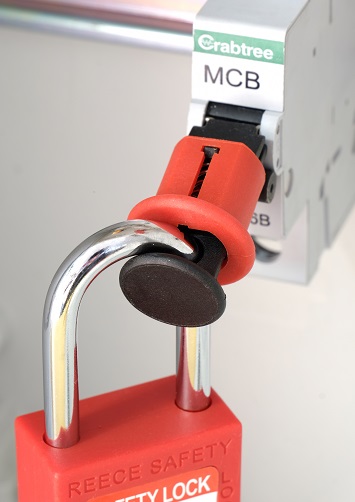Lockout/tagout refers to the procedures that safeguard employees from the sudden and unexpected start-up of machinery; the reenergization of equipment could be dangerous for those close to the machinery, especially if workers believe the equipment is safely shut down. It is imperative to ensure that dangerous machines are completely shut off and are not able to start up unexpectedly before maintenance and repair work take place.
Lockout/tagout particularly applies to any workplace with industrial equipment such as electrical machinery and should always be utilized alongside other safety regulations. The lockout/tagout process should be completed while wearing the correct personal protective equipment (PPE) and following the eight stages of the procedure.
For personal safety, the Occupational Safety and Health Administration (OSHA) requires a formal lockout/tagout program to be in place to ensure that employees are working in a safe environment. An effective lockout/tagout routine should take place every time machinery requires maintenance or cleaning; the routine has since developed into lockout/tagout tryout (LOTOTO), with an emphasis on trying to restart the equipment. This tryout stage ensures the lockout/tagout procedure was successful. It is implemented using the eight steps:
1. Detail Procedures for Equipment
Ensure you have determined the correct procedure for shutting down and restarting the specific equipment/machinery. Prepare the equipment for shutdown, and highlight any potential hazards that may occur. Notify all employees that a lockout procedure is taking place and how long it will affect them.
2. Shut Down the Equipment Properly
Explain and write down the shutdown instructions in detail to reduce the risk of damage to equipment and keep everyone safe. Make sure the shutdown instructions are in the correct sequence and are clearly written for other workers to see; adhering to the manufacturer’s shutdown instructions will ensure the equipment is safely shut off.
3. Equipment Isolation
Ensure that equipment isolation points are identified, labeled, and disconnected from all primary and secondary power supplies. Be sure to isolate all energy sources, including water, steam, electricity, and gas. Identify the process that will relieve any remaining pressure or energy in the machine if required.
4. Apply Lockout Devices
Apply lockout devices to all energy isolation points, and make sure they are tagged according to your company’s safe working procedures. Use the appropriate lockout device along with a tagout device.
5. Energy Control
Inspect the system thoroughly to ensure all moving parts have stopped, and take steps to guard against residual energy. Releasing tension in springs, bracing parts that could fall, and blocking moving parts in hydraulic systems are examples of how to control stored energy at this stage.
6. Verify the Lockout (Tryout)
Once you have disconnected the primary and secondary sources of energy, attempt to start the equipment to verify that the lockout has been successful. Inspect the system to ensure it does not restart, then return all switches to their off positions.
7. Conduct Required Work
At this stage, you can complete the required maintenance or cleaning work on the equipment/machinery safely. Stay alert for any potential hazards or areas of equipment that could restart.
8. Reactivate
Once the work has been completed, the final stage of lockout/tagout can take place, i.e., the equipment can be restarted. Only the responsible person who applied the lockout device can remove it. Once the final lockout device has been removed, the equipment can be reenergized and started again according to the manufacturer’s instructions.
Why LOTOTO?
Proven to be one of the most effective procedures for ensuring worker safety, the LOTOTO procedure is a thorough way to safely isolate equipment. By implementing this procedure, the likelihood of accidental injuries or even fatalities during maintenance or repair work on equipment is greatly minimized.
In order to complete an LOTOTO procedure, all workers should be thoroughly trained on the method and usage of the appropriate devices. This is imperative for ensuring a safe lockout.
| Sonny Brindle is an Account Manager with Reece Safety, a provider of life-critical safety products, such as arc flash PPE, and is a trusted lockout/tagout supplier. It also provides confined space products and training, electrical safety products, and emergency rescue medical equipment. |


